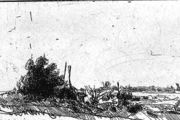Printmaking
A D V E R T I S E M E N T
-
Printmaking originated in
China after
paper was
invented (about A.D. 105). Relief
printing
first flourished in
Europe in the 15th century, when the process of papermaking was imported
from the East. Since that time, relief printing has been augmented by the
various techniques described earlier, and printmaking has continued to be
practiced as one of the fine arts.
Line Art
-
Line art is any image that consists of distinct straight and curved lines
placed against a (usually plain) background, without gradations in
shade
(darkness) or hue (color)
to represent two-dimensional or three-dimensional objects. Line art is usually
monochromatic, although lines may be of different colors.
Etching
-

Etching
Etching is an
intaglio
method of
printmaking in which the image is incised into the surface of a metal plate
using an acid. The acid eats the metal, leaving behind roughened areas, or, if
the surface exposed to the acid is very thin, burning a line into the plate. The
process is believed to have been invented by
Daniel Hopfer (circa 1470�1536) of
Augsburg,
Germany, who
decorated armour in this way, and applied the method to printmaking.
Etching is also a preliminary step in
lithography. The Dutch artist
M. C.
Escher mastered the technique to perfection, specialising in etchings of
impossible structures and oriental interlocking designs.
Etching is also used in the manufacturing of printed circuit boards and
semiconductor devices.
Illustration
-

An illustration of a character from a story; also, an illustration
of illustrations
An illustration is a
visualisation such as a
drawing,
painting,
photograph
or other work of art
that stresses subject more than form. The aim of an illustration is to elucidate
or decorate a story, poem or piece of textual information (such as a
newspaper
article), traditionally by providing a visual representation of something
described in the text. The
editorial cartoon, also known as a political cartoon, is an illustration
containing a political or social message.
Illustrations can be used to display a wide range of subject matter and serve
a variety of functions, such as:
- giving faces to characters in a story
- displaying a number of examples of an item described in an academic
textbook (e.g. A
Typology)
- visualising step-wise sets of instructions in a technical manual
- communicating subtle thematic tone in a narrative
- linking brands to the ideas of human expression, individuality and
creativity
- making a reader laugh or smile
- for fun (to make laugh) funny
Graphs
-
A graph or chart is a type of
information graphic that represents
tabular,
numeric data. Charts are often used to make it easier to understand large
quantities of data and the relationships between different parts of the data.
Diagrams
-
A diagram is a simplified and structured visual representation of concepts,
ideas, constructions, relations, statistical data, etc, used to visualize and
clarify the topic.
Symbols
-
A symbol, in its basic sense, is a conventional representation of a
concept or
quantity; i.e., an idea,
object, concept,
quality, etc.
In more psychological and philosophical terms, all concepts are symbolic in
nature, and representations for these concepts are simply token artifacts that
are
allegorical to (but do not directly codify) a symbolic
meaning, or
symbolism.
Geometric design
Maps
-
A map is a simplified depiction of a
space, a
navigational aid which highlights relations between objects within that space.
Usually, a map is a
two-dimensional, geometrically accurate representation of a
three-dimensional space.
One of the first 'modern' maps was made by
Waldseem�ller.
|
